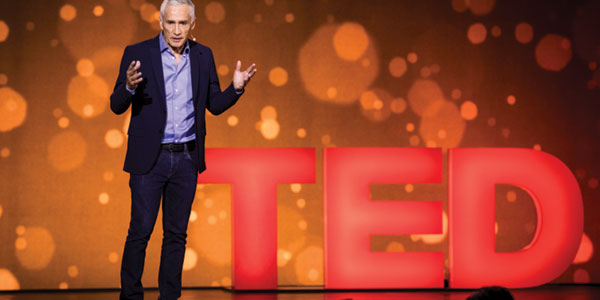
VANCOUVER, Canadá — Cuando me invitaron a dar una plática en la conferencia anual de TED, rápidamente acepté, pero no sabía en realidad en lo que me estaba metiendo. Sabía que era una gran oportunidad de difundir un mensaje a nivel mundial. No sabía de la enorme preparación, trabajo y tensión que implicaba. Ni que sería una de las mejores experiencias profesionales de mi vida.
TED — cuyas siglas significan tecnología, entretenimiento y diseño — es una organización sin fines de lucro, fundada en 1984, y que se ha dado a conocer en el planeta por las extraordinarias, interesantes e inusuales pláticas que difunde. Pero su bien ganada reputación tiene una explicación: Las pláticas siempre son cortas, con un solo tema muy relevante, y se preparan, incansablemente, hasta el último detalle.
Por principio, nadie en TED la llama un discurso — es una plática. La diferencia es importante: En el discurso nos dirigimos a una audiencia lejana, pero en la plática hablamos con alguien, como si lo pudieras tocar. La conexión y el tono son el secreto.
La misma persona que me invitó a las charlas se convirtió en mi guía y asesor. Gerry Garbulsky, un científico argentino, me llevó con inagotable paciencia y contagioso optimismo en un complicado, tortuoso y fascinante proceso. Por primera vez en la historia, TED incluyó el español en su conferencia anual, y tuve el honor de compartir el escenario con el músico Jorge Drexler, la activista por la paz Ingrid Betancourt, la física Gabriela González, la primatóloga Isabel Behncke y el artista Tomás Saraceno.
En mi caso, el proceso de tres meses incluyó el escoger un tema, escribir nueve borradores, memorizar el contenido del final y, por fin, dar la plática frente a cientos de personas en un auditorio (y una potencial audiencia digital de millones).
No fue fácil. Por mi trabajo como periodista me toca dar un par de discursos al mes. La incomodidad de hablar en público o frente a cámaras de televisión es una parte intrínseca de mi profesión, pero los nervios y las expectativas en un evento TED se multiplican exponencialmente.
Con mucha generosidad, a través de los varios ensayos por video y en persona, me dieron invaluables consejos sobre cómo dar una plática exitosa. Ahora los comparto con ustedes:
—Todo se puede decir en 12 minutos o menos. Después de ese tiempo, la gente se distrae o se empieza a aburrir. Esto significa que no debes usar más de 1,800 palabras en tu plática. (Ojalá todos los políticos aprendieran esta regla.)
— Sé tú mismo. Usa palabras y ropa con las que te sientas a gusto. Si tú estás relajado, la audiencia lo estará también. Respira desde el fondo del estómago. (Esto es mucho más difícil de lo que parece.) No grites, habla; el micrófono está para eso.
— Evita ser monótono. Varía tu volumen, velocidad e intensidad. Sé imprevisible. Disfruta el momento y reconoce el privilegio de enviar tu mensaje a muchos.
— Busca conexión con la gente. Velos a los ojos. Háblales a ellos. Muévete en el escenario pero con una razón. A la gente le gusta ver las manos: Muéstralas, pero no seas repetitivo en tus movimientos, ni juegues a ser un conductor de orquesta. Si algo ocurre durante la plática — estornudas, se cae un vaso, alguien grita, te interrumpen o se te olvida lo que vas a decir — reconócelo. Es peor pretender que no ocurrió.
— Practica. Practica. Practica. Hazlo frente a un espejo. Hazlo frente a gente de confianza. Yo repetí mi plática decenas de veces. Dos semanas antes de tu cita, debes tener una clara idea de qué vas a decir. Una semana antes, ya debes poder decirlo sin ayuda de un papel. Pero si prefieres tener unas notas contigo, se vale. Toma agua y limpia y calienta tu garganta antes de empezar. No es necesario memorizar cada palabra. Pero sí hay que memorizar el primero y el último minuto. Y no se te olvide decir “gracias” al final.
Lo que diferencia una buena plática de una clase académica o de un discurso político es que solo la puedas dar tú y nadie más. Todos tenemos al menos una experiencia de vida que es única, irrepetible e intransferible. Esa es la que hay que escoger para cuando te toque dar la mejor plática de tu vida.
(Jorge Ramos, periodista ganador del Emmy, es el principal director de noticias de Univision Network. Ramos, nacido en México, es autor de nueve libros de grandes ventas, el más reciente de los cuales es “A Country for All: An Immigrant Manifesto”.)
(¿Tiene algún comentario o pregunta para Jorge Ramos? Envié un correo electrónico a Jorge.Ramos@nytimes.com. Por favor incluya su nombre, ciudad y país.)
__________________________________________________________________________________
The Best Talk of Your Life
VANCOUVER, Canada — Recently I was invited to give a TED talk, and I accepted without fully understanding what I was getting myself into. I knew it would be a great opportunity to spread a message around the world, but I wasn’t aware how much work — and stress — would be involved. Nor could I foresee that delivering this talk would be one of the best professional experiences of my life.
TED — which stands for technology, entertainment and design — is a nonprofit organization founded in 1984 that has become renowned worldwide for the compelling talks that it sponsors. TED’s reputation is simple to explain: The talks are short, cogent, focused on one relevant topic — and thoroughly prepared, down to the smallest detail.
For starters, nobody at TED calls these talks “speeches.” The distinction is important. In a speech, we tend to talk to a distant audience. But a talk is much more intimate, almost person-to-person. Connection and tone are key.
The Argentine scientist Gerry Garbulsky invited me to give the talk. He guided me with endless patience and infectious optimism through the circuitous, fascinating process of the TED talk. This year, for the first time, TED included Spanish talks at its annual conference. I was honored to share the stage with musician Jorge Drexler, peace activist Ingrid Betancourt, physicist Gabriela González, primatologist Isabel Behncke and artist Tomás Saraceno.
I spent three months in preparation — choosing the topic, writing nine drafts and memorizing the final version — before finally delivering the talk in an auditorium in front of hundreds of people (and a potential virtual audience of millions).
It wasn’t easy. Because of my work as a journalist, I give a couple of speeches a month. But with a TED talk, nerves and expectations multiply exponentially.
Gerry and other people generously gave me advice about how to give a successful talk, and I want to share some pointers with you:
— Say what you need to in 12 minutes or less. After that, audiences tend to get distracted or bored. This means that you should use no more than 1,800 words in your talk. (I wish every politician would take this advice to heart.)
— Be yourself. Use words and wear clothes that make you feel comfortable. If you’re relaxed, the audience will be, too. Breathe from the bottom of your belly (this is much harder than it sounds). And you needn’t yell: The microphone is there for a reason.
— Vary the volume, speed and intensity of your voice. Be unpredictable. Enjoy the moment, and embrace the privilege of sharing your message with many people.
— Connect with the audience. Talk to them as if you were one on one. Make eye contact. Move around the stage. People like to see your hands, but don’t be repetitive with your gestures. If something unexpected happens during the talk — you sneeze, you drop a glass, someone yells, you’re interrupted, you forget what you were going to say — accept it. Pretending that it didn’t happen makes things worse.
— Practice. And practice some more. Say your talk to your mirror or to people you trust. I rehearsed my talk dozens of times. Two weeks before the date, you must have a very clear idea of what you’re going to say. One week before, you must be able to say it without looking at notes. But if you prefer to have your notes with you, that’s OK. While it’s not necessary to memorize every word, you should at least memorize the first and the last few minutes.
— Before starting, drink water. Clear and warm up your throat.
— And at the end, don’t forget to say “thank you.”
The difference between a good talk and a scholarly lecture or political speech is that you, and only you, can give it. We’ll all have at least one life experience that calls for just the right words. That’s when you’ll have to give the best talk of your life.
(Jorge Ramos, an Emmy Award-winning journalist, is a news anchor on Univision. Originally from Mexico and now based in Florida, Ramos is the author of several best-selling books. His latest is “Take a Stand: Lessons From Rebels.” Email him at jorge.ramos@nytimes.com.)









